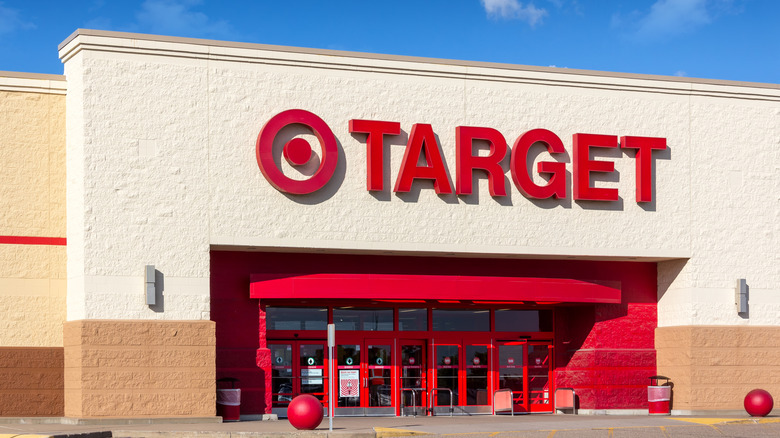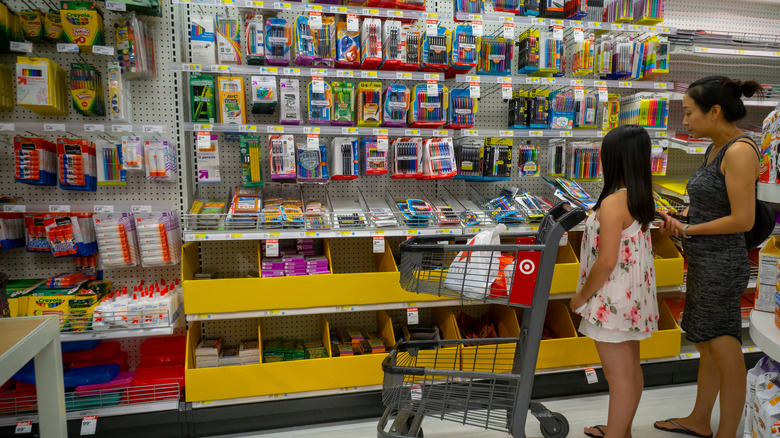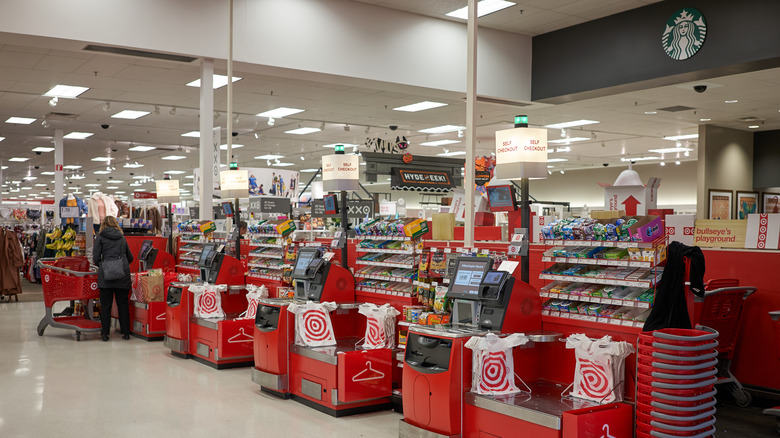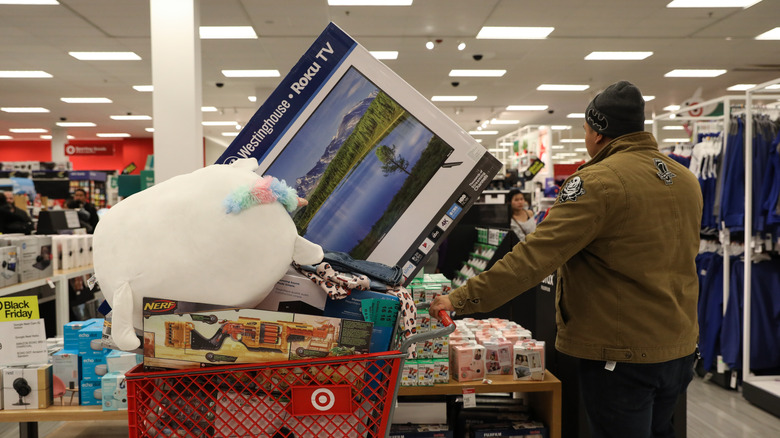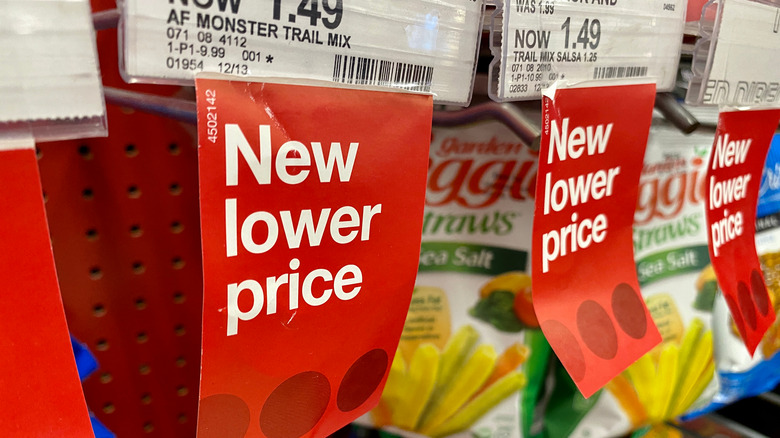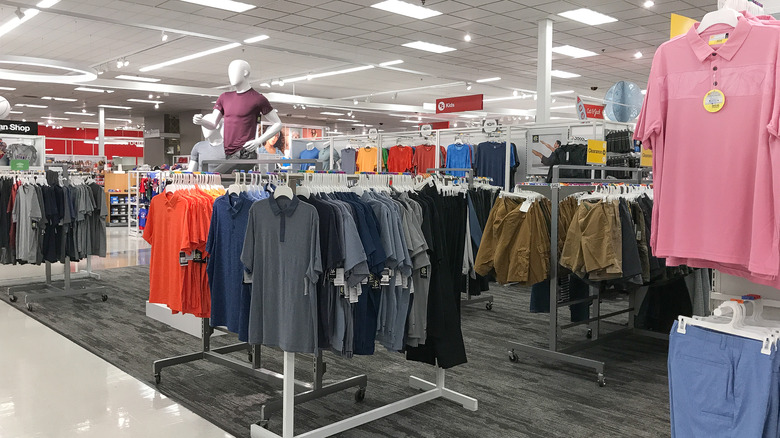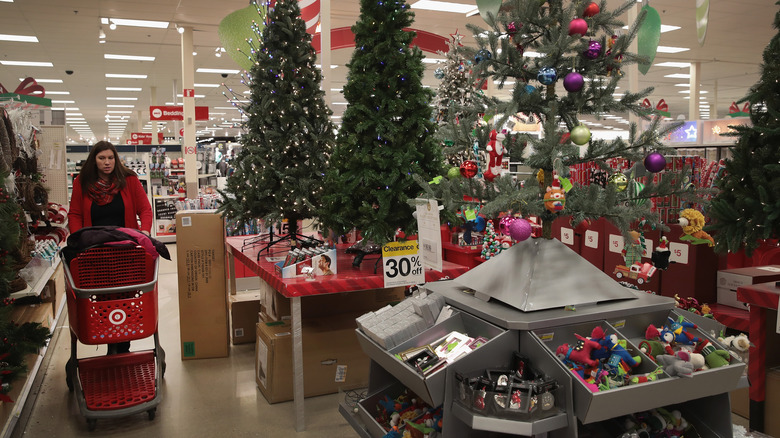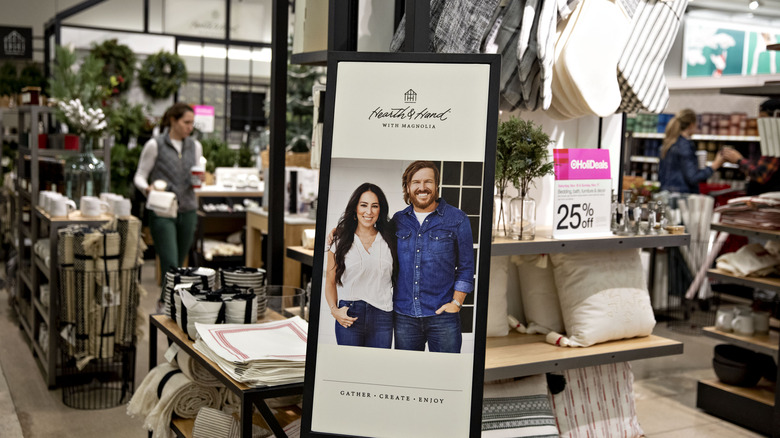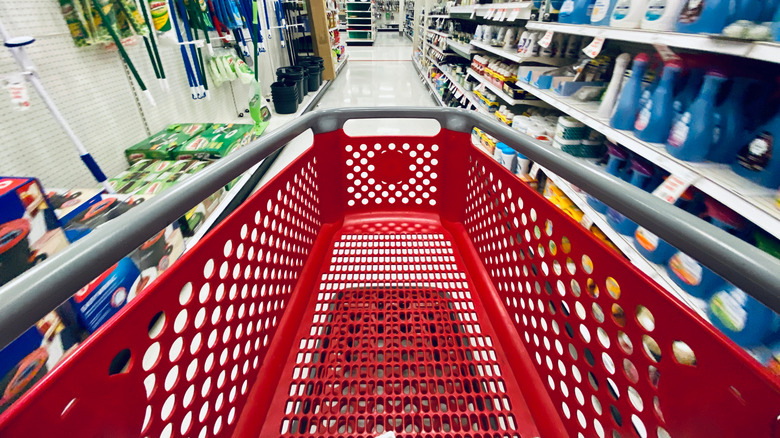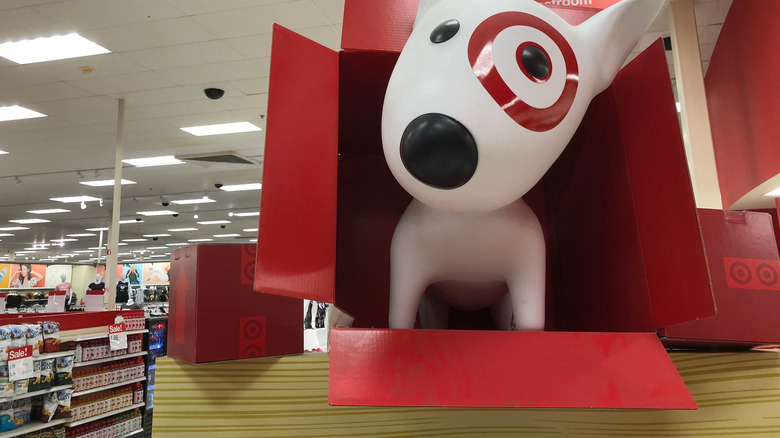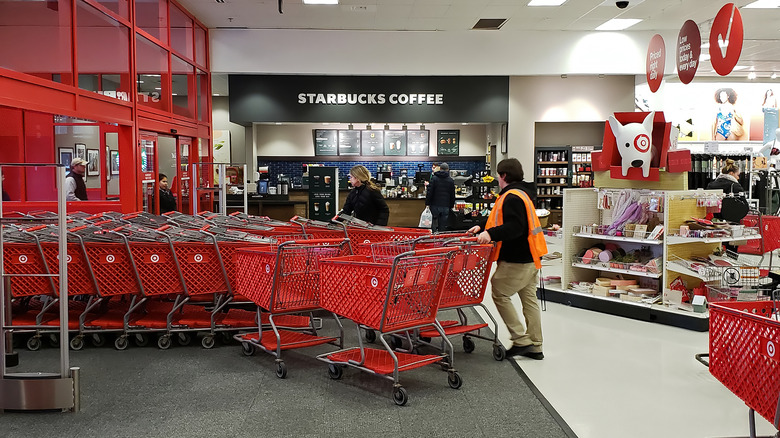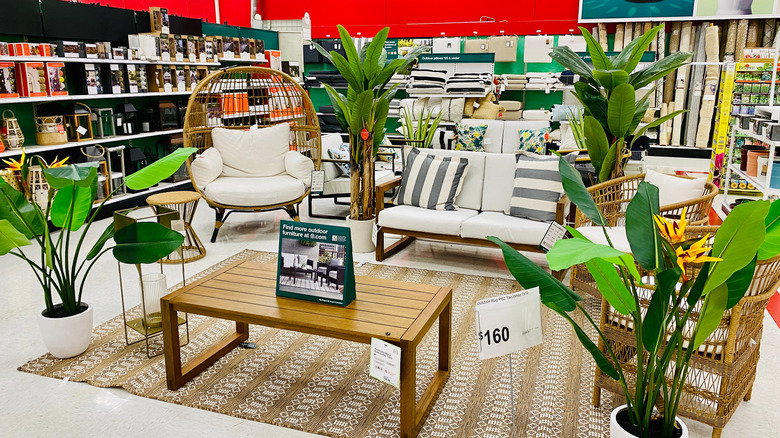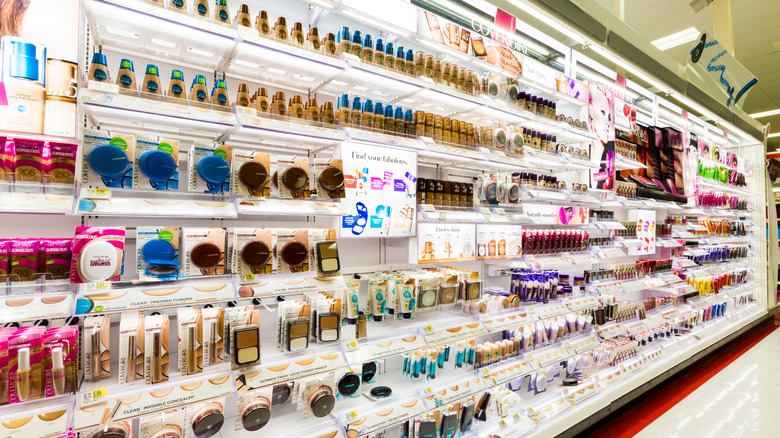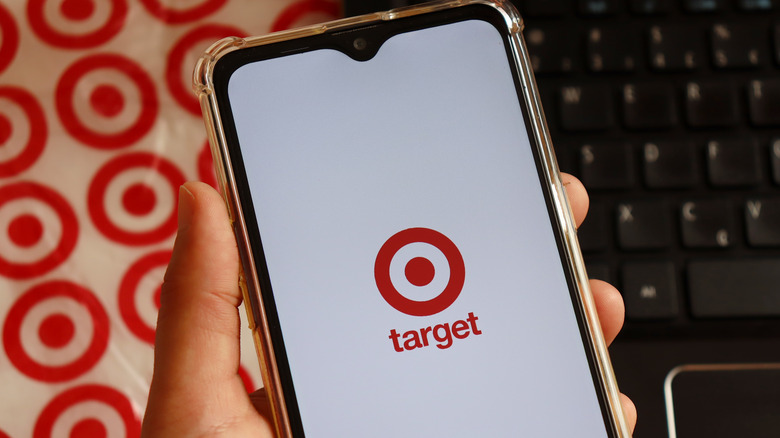How Target Gets You To Spend More Money Than You Planned To
Raise your hand if you've ever walked into your local Target searching for toothpaste or shampoo and walked out over an hour later with a cart full of holiday decor, embroidered shower curtains, and a decorative cake stand. And you don't even bake. If something like this has ever happened to you, know you're not alone. It's a very real phenomenon referred to as the "Target Effect," and everyone from People to Urban Dictionary has written about it.
There are plenty of scientific reasons why shoppers overspend on Target trips. The beloved retailer has hit the bullseye when it comes to understanding their customers and creating a welcoming shopping environment. Between the attractive displays and endless bargains, it's easy to lose track of time ... and your spending. If repeated trips to Target have left your wallet feeling depleted, you might want to check out these sneaky ways the store gets you to spend more money than you planned.
Masterful cross-selling
One thing Target is exceptional at is cross-sell. Cross-selling is putting related products next to each other to encourage more sales, as marketing professor Tom Meyvis from New York University's Stern School of Business explains to Refinery 29. Often this involves merchandise from completely different categories that you would not necessarily expect to see in the same area of the store.
For example, if you go into the store looking for a tool kit and find first aid supplies sitting on the shelf next to it, you'll be more likely to buy both items. Another example is seeing sunscreen next to the sunglasses display or memory cards next to cameras in the electronics department. Once you see the different products next to each other, it makes sense to have both. Thanks to Target's genius product placement, your shopping cart will probably fill up quickly even if you go in looking for just a few items.
Smart store layout
One of the best parts about the Target shopping experience is the store layout. From the moment you step inside the store, clear signage leads you to what you're looking for. And once you're in the right aisle, there are usually sales advisors available to provide you with knowledgeable advice or product guidance, according to Insider. Additionally, each store is designed with a flowing, open layout to encourage you to walk around the entire retail space. The openness makes merchandise more visible, which reduces tension and creates a pleasant atmosphere.
But make no mistake, the appealing store layout has been specifically designed to tempt shoppers to spend more money. Customers are more likely to stay in these feel-good types of environments longer, which leads to more purchases and dollars spent. Keep in mind that the inside of your local Target has been carefully designed to influence customers' shopping behaviors and produce additional sales.
Enticing atmosphere
Between the nice lighting, upbeat music, and bright red and white color palette, Target's enticing interiors are designed to make you stay (and shop) for longer than you probably planned. Dr. Kevin Chapman, a Kentucky-based psychologist interviewed by Refinery 29, credits Target's pleasant shopping atmosphere to why people usually spend so much money in-store. The company has a history of working with some of the best and brightest designers to create a happy aesthetic that draws people in.
On top of that, Target is in the process of making its stores even more tempting. In 2021, about 150 Target stores received a significant makeover, including upgrades to the Guest Services, Order Pickup, and Drive Up areas. This means over 800 stores have been given a facelift in the last four years. According to A Bullseye View, these remodels make your Target trip even easier. They also provide better access to their same-day services, meaning shoppers don't have to worry about lugging larger items back home.
Psychological pricing
Like many other retailers, Target has adopted 'psychological pricing' or 'charm pricing.' According to Wiser, this involves putting an odd number at the end of a price. An example of this is marking an item $9.99 instead of rounding up to $10. This strategy makes it feel like products are on sale even if they're not, per Refinery 29. Customers often read the slightly lower price and view it as nine dollars instead of 10, even though technically, a one-cent price reduction does not make a difference. Charm pricing is so effective because shoppers often read the first number on a tag and disregard the last digits. It's so simple, but even the best of us fall prey to it.
In addition, Target markets itself as a store where one can find good deals, so people are more likely to expect bargains while shopping. This means you're more likely to throw a wellness candle or similar treat into your cart without checking the price first. This strategy would not work as easily at a designer department store like Nordstrom, for example.
Treasure hunting shopping experience
If shopping at Target makes you feel like you're on a treasure hunt searching for gold, you're not alone. The company is constantly rotating stock in and out, adding new inventory, and stocking exclusive designer collaborations to keep customers excited and coming back for more. During previous partnerships with brands like Vineyard Vines and Hunter, Target only stocked a limited number of items to build buzz about them selling out. Thanks to the in-flow of fresh products, shoppers will sometimes worry they will miss out if they don't strike while the iron is hot. This makes them more likely to impulse buy products on the spot, according to Insider.
While treasure hunt shopping is undoubtedly an effective strategy, it has backfired on Target in the past. For example, during its Hunter collaboration, the stock was so limited customers complained that it didn't even make it to their local store.
Amazing seasonal selection
You can always count on Target to dial up the holiday cheer. The retailer makes the holiday shopping experience magical every year by adding plenty of tinsel decorations, bedazzled Christmas trees, and tons of colorful stocking stuffers around the store. But December is not the only time of year for seasonal displays. Every store has a specific section devoted to seasonal items, which rotates depending on the holiday. From Easter to Valentine's Day, this festive part of the store is filled with creative and unique finds all year round. According to Insider, some customers make a Target run for the sole purpose of browsing the seasonal displays.
One of the main draws of the winter holiday section is the annual designer collections. Acclaimed designers like Justina Blakeney, Studio McGee, and Joanna Gaines have created unique collections for Target filled with cozy blankets, candles, snow globes, and everything else on your holiday wish list (via CNN). It's no wonder customers flock to this part of the store.
Unique partnerships and collaborations
For over 20 years, Target has been partnering with renowned designers, celebrities, and brands. Known as their Design for All program, over 175 different partnerships have been introduced over the years, as per A Bullseye View. This includes a Victoria Beckham-approved clothing line, a homeware line with Chip and Joanna Gaines, and a fashion line collaboration with designer Zac Posen. The collections have even gained cult followings over the years, and plenty of fashionistas have lined up outside their neighborhood Target stores to score one of the must-have pieces. The exclusive collaborations feature on-trend styles at affordable prices, making them a big draw for shoppers who often go on Target runs specifically to shop these special designs before they sell out.
However, according to The Washington Post, these collections do not generate big sales numbers on their own. Most of the revenue comes from shoppers buying everything else on their shopping lists (and more) once inside the store. Hello, Target Effect.
Large grocery carts
A good shopping cart is key to a positive shopping experience. Carts with broken wheels, faulty steering, or squeaky sounds can all negatively impact your time in the aisles and cut shopping trips short. Target is well aware of the importance of the shopping cart, which is why their carts are expertly designed to ensure they run perfectly smoothly.
As reported by NBC News, Target enlisted the help of a Boston company called Design Continuum to revamp their shopping carts. Features include an ergonomic handrail for easy steering, a lightweight recycled plastic, and the brand's signature tomato red color. Add in the fact that most Target stores have extra-large carts over 1/3 the size of typical grocery carts, and it's not surprising shoppers often feel compelled to whip out their wallets. Having just a couple of small items in an elephant-sized cart could make you feel like you're not buying enough. The increased size and high-quality design send a subtle signal to shoppers that the store itself is high-quality, which often leads to more purchases.
Dollar display at the entrance
If you've ever been to Target, you're probably familiar with Bullseye's Playground, the store's eye-catching dollar section. With large displays of the store mascot, Bullseye, jumping into boxes and wagging their tail, you can't miss this bright and cheerful bargain area. Here you'll find cute products related to the local area, kids toys, or seasonal decorations on the shelves. Every item is priced somewhere between $1 and $5, making it easy to drop a bunch of things into your cart. And since it's placed right next to the checkout section, shoppers see it right before paying and have one last opportunity to impulse buy.
According to Target, Bullseye Playground is meant to deliver a fun and exciting shopping experience for customers. In fact, it's so fun that you might find yourself walking out of the store with a cart full of random items, even if you don't actually need them.
Customers never go hungry
Starbucks is a familiar face within Target stores, making it easy for customers to fuel up with a Frappuccino or sip a latte while shopping for home decor. Starbucks and Target have been working together since 1999, and in 2016 there were a whopping 1,300 cafes in Target stores around the country, as per A Bullseye View. Most store locations also offer a food court or cafe so customers can grab a bite to eat before or after shopping, creating an enticing social atmosphere for shoppers.
Having cafes and food outlets inside a store actually increases store foot traffic, according to Insider. This is because customers are more likely to meet for lunch inside the store if there are restaurants, and they will often shop for a while before leaving. Guests are also more likely to linger and spend more time exploring store aisles if they can have a coffee or two. Who knew coffee and retail therapy made such a great match?
Target knows its customers
It's no coincidence that you find yourself walking past a Target display and wanting to buy literally every single item. For decades, the company has spent a lot of time and money researching its customer base, conducting focus groups, and collecting metadata to understand its guests better.
Philadelphia University lecturer David Loranger told Philadelphia Magazine that Target knows almost everything about its customers, including their age, gender, income, location, and lifestyle hobbies. Shoppers are even given an internal Guest ID number to keep track of every product they purchase. Target then uses this information to tailor its product selection and present items in a way that resonates with guests and ultimately drives sales. While many companies also have analytics departments focused on understanding customer behavior and how to market to them, Target has always been ahead of the curve. This is why the retailer is skilled at identifying products its customers simply can't leave the store without.
A high-end feel
Target's price points might be similar to chains like Walmart and Old Navy, but the retailer somehow manages to distinguish itself with a more high-end feel. Part of this comes down to its reputation for pioneering partnerships with high-end designers to produce trendy and accessible fashion. Another factor is the way the merchandise is displayed within stores, as per Philadelphia Magazine.
While places like Forever 21 and Old Navy often have messy, sky-high piles of clothes on their shelves, Target copies strategies from department stores like Bloomingdale's. Their products are neat, organized, and visually appealing, and you'll often see a select number of shirts displayed in the clothing section. Since shoppers see a limited number of a specific item, they are more inclined to think it is special and make an impulse buy. Similarly, Target's technology departments take cues from Apple stores, elevating the shopping experience with a minimalist design aesthetic.
Makes shopping feel like a game
If the cheerful store atmosphere didn't already have you hooked on all things Target, the company's digital shopping experience is designed to lure shoppers in with addictive discounts and money-saving features. Target's RedCard is a store credit card that gives shoppers a 5% discount on every online and in-store purchase. There's also the Target app, which helps users access exclusive Circle offers and easy payment features. When customers are at checkout, they can literally watch the prices drop before their eyes and get a dopamine rush known as a 'shopper's high,' according to Elle.
Philadelphia Magazine says the digital features turn shopping into a game as customers walk around the store scanning barcodes on products to unlock secret bargains. Instead of simply pricing these products to reflect their actual value, Target offers these small discounts to trick guests into thinking they are getting a good deal (even if this is not always the case).
